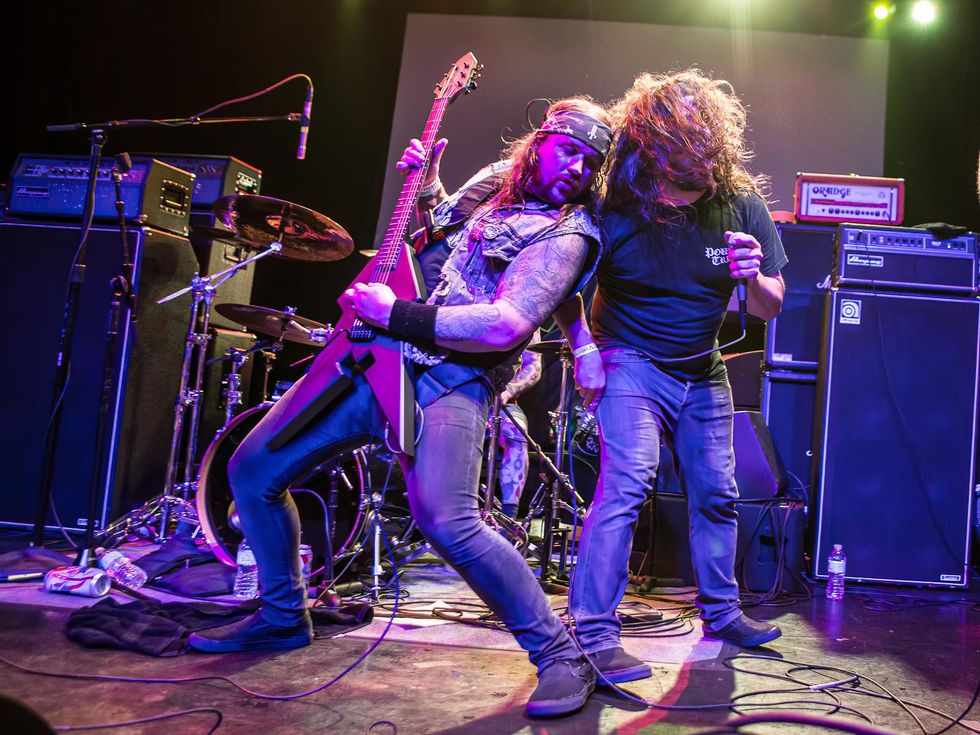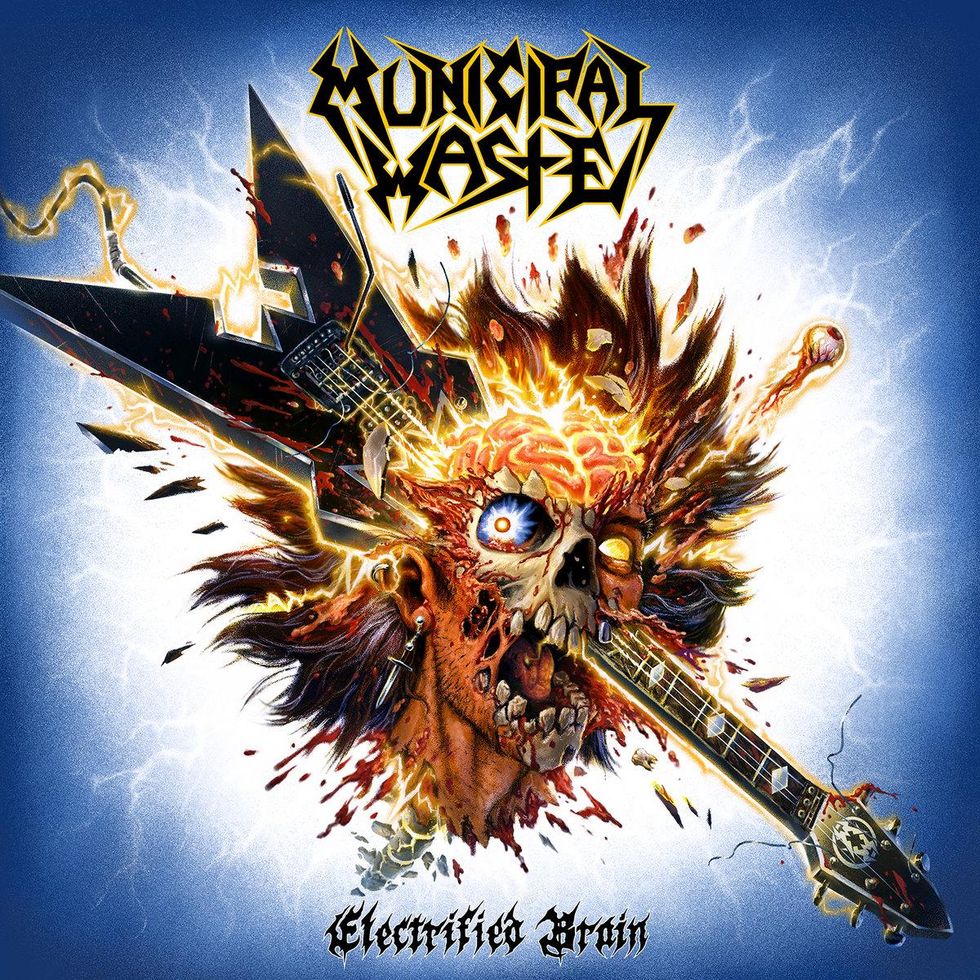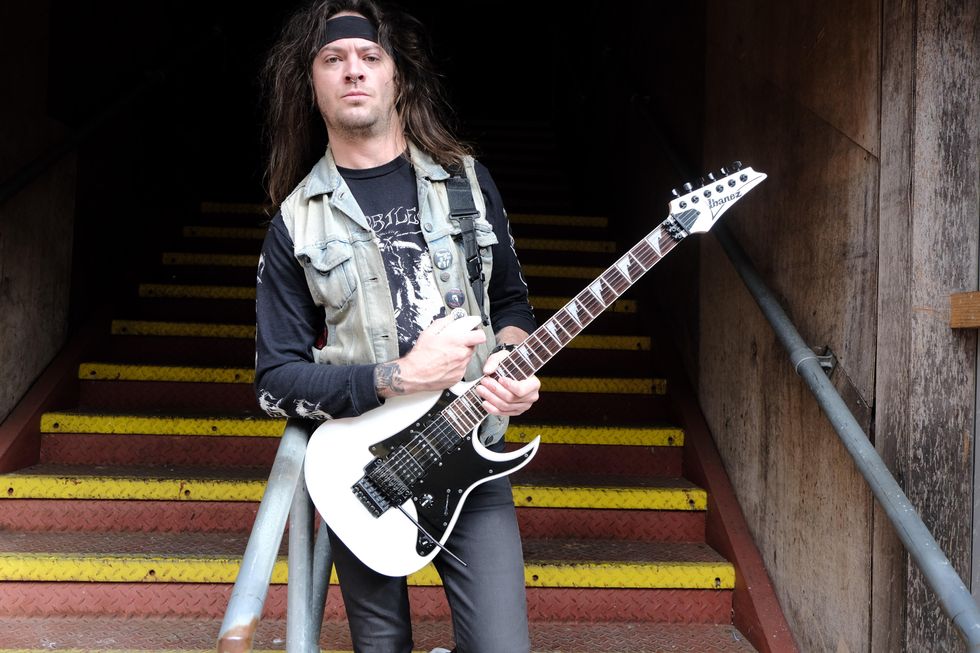Municipal Waste guitarist Ryan Waste is passionate about old-school metal. “I’m as much a fan as a player,” he attests, “so I try to keep as true to the roots as possible.” His allegiance to metal’s early days is loud and clear on Electrified Brain—the band’s most recent record—a 14-track, 34-minute explosion of vintage, full-throttle thrash at its finest. Leaning heavily into the sonic template forged by albums like Metallica’s Ride the Lightningand Slayer’s Reign in Blood, Electrified Brain easily qualifies as a contemporary torchbearer for the genre and effectively associates Municipal Waste with the New Wave of Traditional Heavy Metal scene. By embracing the tried-and-true ’80s-era sonic stew of Marshall amps and standard-tuned guitars, and by avoiding modern production aesthetics that rely on click tracks and drop-tunings, the band has crafted an album that captures the incendiary spark of pure, unadulterated OG thrash.
Since forming in 2001 in Richmond, Virginia, Municipal Waste has released seven studio albums, three EPs, and four splits, with founding members Waste and lead vocalist Tony Foresta solidly guiding their musical amalgamation of ’80s thrash and hardcore punk. The current lineup also includes Philip “Landphil” Hall on bass, Dave Witte on drums, and their latest addition, Nick Poulos, on lead guitar. Long-running metal label Nuclear Blast released Electrified Brain, the follow-up to 2017’s widely praised Slime and Punishment, which was the first to feature Poulos on guitar—though the band also released the EP The Last Rager in 2019. Prior to that, Municipal Waste was a four-piece, with Waste handling all guitar duties.
MUNICIPAL WASTE – High Speed Steel (OFFICIAL LYRIC VIDEO)
Over the course of the last two decades, albums like The Art of Partying (2007) and The Fatal Feast (2012) have burnished Municipal Waste’s reputation as the world’s foremost purveyors of “party thrash.” Electrified Brain continues that trend across a set of short, insistent songs with tongue-in-cheek titles like “Last Crawl,” “Ten Cent Beer Night,” “Crank the Heat,” and “Paranormal Janitor.” A good example of putting the “party” into “party thrash” is the “Rock You Like a Hurricane” riff that concludes the propulsive “Ten Cent Beer Night.” These dudes have a sense of humor, and it’s one of Municipal Waste’s coolest attributes.
Poulos confirms that the initial intent for Electrified Brain was to be a bit more “traditional,” and cites elements of Metallica’s “For Whom the Bell Tolls” in the song “High Speed Steel.” “There’s a little lead that I do at the end that is pretty ‘Kirk-y,’” he says.
Beyond these towering musical influences, the pandemic also had a profound impact on the creation of Electrified Brain. “We had more time than we’ve ever had for an album,” recalls Waste. “Instead of rushing through—write, hit the studio, hit the road—this one was like, ‘Okay, we’re going to write, let the songs marinate a little bit, revisit them, and then collectively go in the studio.’” During the height of the pandemic, they holed up in Redwoods Recording Studio with engineer Arthur Rizk in Philadelphia, Pennsylvania, for two weeks and got down to business.
“Now that we have the power to pull off double guitars live, we’re going to really let it shine.” —Ryan Waste
“We were all masked up—five of us—in an Airbnb and just taking Lyft to South Street every day and working 11, sometimes 12, hours,” recalls Poulos. “We were so ready to do just about anything as a band. Obviously, we couldn’t play shows at that time, but the studio was a real cool escape from the world and everything that was happening.”
Poulos says both he and Waste recorded two guitar tracks each per song, so when you listen to Electrified Brain, you’re hearing four rhythm guitar tracks. “We would finish a pass of the song, punch-in, fix whatever mistakes, and then go ahead and do a whole other take,” he recalls.
Poulos cut his rhythm tracks with his late father’s vintage Gibson Explorer, calling on a pair of Marshalls for his amplification needs: his own ’88 JCM800 for his primary rhythm tracks, and one of Rizk’s studio Marshalls for his second tracks. Poulos also “messed around with” a Boss SD-1 Super Overdrive. “I play out of my JCM800 with the reverb cranked at about two-and-a-half, three o’clock, with a Tube Screamer and Overdrive. I just run them both and have it dialed in so it’s not completely noisy. It’s pretty primitive, honestly. There’s really not much to it, but when you put a microphone up to it the way Arthur did, it sounds awesome—very Slayer, Trouble, even early ’Tallica. You just can’t go wrong.”
Ryan Waste’s Gear

Back in the early days of the band, Ryan Waste, here with singer Tony Foresta, designed the Municipal Waste logo. Since 2008, he’s worked with a series of builders to bring that logo to life, culminating in his crushing signature model, the RIP MW-AX.
Guitars
- RIP Custom Guitars MW-AX with Kahler 2300 Tremolo and Seymour Duncan JB Trembucker pickup
Strings & Picks
- Ernie Ball Regular Slinky (.010–.046)
- Dunlop Tortex Standard .73 mm
Amps
Effects
- Ibanez TS9 Tube Screamer
- Boss TU-3 Chromatic Tuner
Waste followed the same tracking protocol, using his own JCM800 amp from ’86 with a V2 mod that boosts the gain and the low end. “It’s definitely loud as shit, but a little less gain-y than mine,” says Poulos. The guitarist runs just a single Ibanez Tube Screamer in front.
Waste tracked Electrified Brain using his RIP Custom Guitars MW-AX, built by Rob Gray. It’s a custom model in the shape of the band’s logo. “I’m a left-handed player. Not being able to find a Flying V or find guitars at a guitar shop, I had a custom guitar made in the shape of our logo as far back as 2008,” explains Waste. In the time since, he’s turned to various builders to make the guitar, from luthier Andy Strangio, who made the initial model, to Fernandes, and to local Richmond builder John Gonzales. “I’ve had five incarnations,” explains Waste. “And now, I teamed up with Rob Gray at RIP Custom Guitars, which is Radical Instrument Products. He’s made the final MW-AX that I’ve actually marketed and made a signature model out of that kids can buy.”

To capture the most brutal sounds around, the band headed up I-95 to Philadelphia and engineer Arthur Rizk. In the City of Brotherly Love, they spent two weeks carefully crafting their riffage—though they recorded their guitar leads at the home of bassist Philip “Landphil” Hall.
Both guitarists credit Rizk with helping them get the desired results. “He’s a great guitar player himself and understands that we want a crunchy, natural tone,” says Waste. “He got my favorite sounds, drums-and guitar-wise, on this album, so I was psyched.”
Even though Electrified Brain is the third Municipal Waste record to include Poulos, it’s their first release to prominently feature a lot of lead guitar playing. “On this one, we’re really letting him shine with more leads,” says Waste. The guitarists decided to take a different approach to tracking their solos than they did to their rhythm parts, cutting them at bassist Philip Hall’s house and shipping them to Rizk fox mixing.
Rig Rundown: Municipal Waste
We filmed a Rig Rundown with the thrash twins back in August — see their live setups up close.
Poulos says he went into each solo with a rough blueprint of what he was going to play before they hit record. “For most of the stuff, I had an idea of how I was going to execute it, but I definitely came up with a couple of cool things on the fly that I’m really stoked on.” He differentiated his tone by using his Ibanez RG550 for solos, and adds, “I just used a couple of different pedals. For the leads, I used a Waza Craft Metal Zone. It’s not like most Metal Zones. I know a lot of people hear the term Metal Zone and think basement metal and Battle of the Bands, but the mod definitely helped make it less noisy. You can really just tone back and dial it in to be great for leads.”
Poulos also admits that in the past he’s been terrified when it came to tracking leads in the studio. “But now, especially working with Phil, we have this rapport,” he explains. “It’s calm, it’s easy. And my abilities have improved over the past couple of years. I really try to do some extracurricular activities, as far as thinking outside of my go-to tricks and my normal toolbox of moves. I’m level-headed, I’m ready to do it, and it feels good. Once you hit something really sick, it’s like, ‘Wow, that sounds really cool.’”
Nick Poulos’ Gear

Electrified Brain is Nick Poulos’ third album with the band, but this time, Waste says, “We’re really letting him shine.”
Photo by Adam Malik
Guitars
- Ibanez RG550 Genesis Collection
- Gibson Explorer
Strings & Picks
- Ernie Ball Regular Slinky (.010–.046)
- Dunlop Nylon Max Grip 1 mm
Amps
Effects
- Ibanez TS9 Tube Screamer
- Boss SD-1 Super Overdrive
- Boss MT-2W Waza Craft Metal Zone
- Boss TU-3 Chromatic Tuner
The band also embraced more of the creative possibilities of their two-guitar lineup. “Now that we have the power to pull off double guitars live, we’re going to really let it shine,” promises Waste. On “Last Crawl,” they took the opportunity to trade leads. “The trade-off stuff is cool,” he says. “I think maybe we’ll do more of that.” But it’s also refreshing for Waste to be able to focus on his rhythm work. “It was just such a relief, like, ‘Okay, you’re the lead guitar player now.’ I have no ego about it whatsoever, man.”
Perhaps their generous guitar partnership stems from the guitarists’ collaborations outside of the band, which have been ongoing for some years. They both play together in two more traditional heavy metal bands, Bat and Vulture. Waste plays bass in both, which may account for his willingness to play a more supportive role. It also perhaps highlights his seemingly innate ability to conjure great, single-note, air-guitar-worthy riffs. “I was a bass player long before I was a guitar player, so, honestly, I’m more comfortable playing bass,” he confesses. “I even feel more proficient at bass. I didn’t pick up a guitar until I was 18. Back then it was funny. I played bass since I was 13, and everyone told me I played bass like a guitar player, because I’d be up high on the neck doing stuff. So, I was like, ‘I might as well get a guitar.’ And now I feel like I play guitar like a bass player, so I can’t win, man.” [laughter]
“The studio was a real cool escape from the world and everything that was happening at the time.” —Nick Poulos
Waste points to Geezer Butler and Lemmy as huge influences, and says he loves “bass that stands out and you can hear it. I’m a champion of the bass. I want to be able to hear it in recordings. I love a nice distorted, loud bass tone. I love Mob Rules, the Dio Sabbath— ‘Country Girl.’ There are some bass lines on that one.” Ultimately, Waste says his playing style likely evolved from his sense that “riffs are more important—you can shred all day, but can you write a song?”
Poulos cites a slew of influences, starting with “a lot of the British guys, like Jeff Beck. These cool, nonchalant, guitar slingers—they just made it look so easy.” He says he got really into Carcass when he was young and is a fan of guitarists Bill Steer and Michael Amott. “I love Glenn Tipton’s playing on a lot of those post-’70s -era [Judas] Priest records too, like the early-’80 stuff, where he really honed his ability and got a little flashier.” He goes on to gush about Whitesnake’s Adrian Vandenberg, Vinnie Moore, and Thin Lizzy—singling out Gary Moore. “Also, my dad was a blues guy,” he adds. “He always instilled this sense of how to work around a pentatonic and make it sound more bluesy, and that’s driven into my skull. I’m definitely trying to open my mind to stuff like Freddie King.”
After discussing a wide range of players, Poulos circles back to the conversation about the band’s intent to make a more traditional-sounding record, and ultimately concludes that labeling Municipal Waste could be a futile endeavor. “The ‘New Wave of Traditional Heavy Metal’ label is a little ridiculous,” he chuckles. “Heavy metal is timeless.”
Municipal Waste – Live @ Hellfest 2019 (Full Live HiRes)
Thrash riffs, gang vocals, guitarmony, crushing riffs … Municipal Waste has it all. Check out lefty Ryan Waste’s custom guitar in action as the band wreaks havoc at Hellfest in Clisson, France, in 2019.
From Your Site Articles
Related Articles Around the Web









